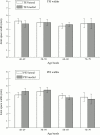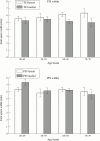Radiographic assessment of symptomatic knee osteoarthritis in the community: definitions and normal joint space
- PMID: 9893570
- PMCID: PMC1752476
- DOI: 10.1136/ard.57.10.595
Radiographic assessment of symptomatic knee osteoarthritis in the community: definitions and normal joint space
Abstract
Objective: To evaluate radiographic features of osteoarthritis (OA) to determine which is more closely associated with knee pain and hence might be used as a radiographic definition of OA in the community. To evaluate joint space width in normal subjects.
Methods: 452 subjects from a case-control community study of knee pain (294 women, 158 men, mean age 62 years, range 40-80) underwent AP standing and midflexion skyline radiographs. Joint space width, measured by metered calliper to 0.1 mm, and graded individual features of OA (osteophyte 0-3, narrowing 0-3, sclerosis 0-1, cysts 0-1) were assessed in all three compartments independently by two observers who were blind to clinical status. Subjects were categorised as having knee pain by a positive response to both parts of the question "Have you ever had pain in or around the knee on most days for at least a month? If so, have you experienced any pain during the last year?"
Results: Intraobserver reproducibility for joint space width measurements was to within +/- 0.4 mm (95% CI for limits of agreement); kappa values for grading were > 0.7. One hundred and twenty five subjects were without knee pain or osteophyte. In these radiographically normal knees, mean joint space width varied according to sex but did not decrease with age. A definition based on the presence of osteophyte > or = grade 1 in any compartment was more efficient at predicting pain than definitions based on either measurement or grading of joint space; there was no clear threshold of joint space loss at which the likelihood of pain substantially increased. The presence of osteophyte at the patellofemoral joint (PFJ) was more sensitive but less specific than at the tibiofemoral joint (TFJ); the addition of PFJ assessment improved sensitivity from 38.1% to 62.3% with a reduction in specificity from 82.7% to 58.7% for the presence of knee pain.
Conclusion: Among men and women in the community, osteophyte is the radiographic feature that associates best with knee pain. Radiographic assessment of both TFJ and PFJ should be included in all community studies. Joint space loss is not a feature of asymptomatic aging, and there is not a biological cut off for joint space width below which the likelihood of knee pain markedly increases.
Figures
Similar articles
-
UK community prevalence of knee chondrocalcinosis: evidence that correlation with osteoarthritis is through a shared association with osteophyte.Ann Rheum Dis. 2003 Jun;62(6):513-8. doi: 10.1136/ard.62.6.513. Ann Rheum Dis. 2003. PMID: 12759286 Free PMC article.
-
Differences in radiographic features of knee osteoarthritis in African-Americans and Caucasians: the Johnston county osteoarthritis project.Osteoarthritis Cartilage. 2009 Dec;17(12):1554-61. doi: 10.1016/j.joca.2009.07.011. Epub 2009 Sep 1. Osteoarthritis Cartilage. 2009. PMID: 19735758 Free PMC article.
-
Age and sex differences in hip joint space among asymptomatic subjects without structural change: implications for epidemiologic studies.Arthritis Rheum. 2003 Apr;48(4):1041-6. doi: 10.1002/art.10886. Arthritis Rheum. 2003. PMID: 12687547
-
Differences in descriptions of Kellgren and Lawrence grades of knee osteoarthritis.Ann Rheum Dis. 2008 Jul;67(7):1034-6. doi: 10.1136/ard.2007.079020. Epub 2008 Jan 15. Ann Rheum Dis. 2008. PMID: 18198197 Review.
-
The use of radiographs in assessing the severity of knee osteoarthritis.J Rheumatol Suppl. 1991 Feb;27:38-9. J Rheumatol Suppl. 1991. PMID: 2027124 Review.
Cited by
-
WHAT IS THE BEST QUESTIONNAIRE FOR MONITORING THE PHYSICAL CHARACTERISTICS OF PATIENTS WITH KNEE OSTEOARTHRITIS IN THE BRAZILIAN POPULATION?Rev Bras Ortop. 2015 Dec 8;46(3):256-61. doi: 10.1016/S2255-4971(15)30191-9. eCollection 2011 May-Jun. Rev Bras Ortop. 2015. PMID: 27047817 Free PMC article.
-
The knee skyline radiograph: its usefulness in the diagnosis of patello-femoral osteoarthritis.Int Orthop. 2007 Apr;31(2):247-52. doi: 10.1007/s00264-006-0167-y. Epub 2006 Jun 17. Int Orthop. 2007. PMID: 16783548 Free PMC article.
-
An evaluation of chemical arthrodesis of the proximal interphalangeal joint in the horse by using monoiodoacetate.Can J Vet Res. 2000 Oct;64(4):212-21. Can J Vet Res. 2000. PMID: 11041498 Free PMC article. Clinical Trial.
-
Labelling chronic illness in primary care: a good or a bad thing?Br J Gen Pract. 2004 Dec;54(509):932-8. Br J Gen Pract. 2004. PMID: 15588540 Free PMC article. Review.
-
Case definitions of knee osteoarthritis in 4,151 unselected subjects: relevance for epidemiological studies: the Copenhagen Osteoarthritis Study.Skeletal Radiol. 2010 Sep;39(9):859-66. doi: 10.1007/s00256-009-0856-x. Epub 2010 Jan 30. Skeletal Radiol. 2010. PMID: 20119632
References
Publication types
MeSH terms
LinkOut - more resources
Full Text Sources
Other Literature Sources



